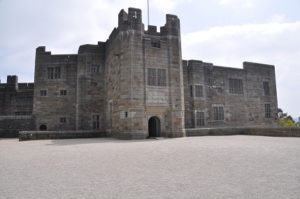
- This event has passed.
Historic Building workshop, Care and repair of historic masonry, Castle Drogo, Devon – SOLD OUT
July 10, 2018, 09:30 - 17:00
Historic Building workshops – SOLD OUT
Care & repair of historic brickwork
Date: Tuesday 10 July 2018
When: 0930 – 1700
Where: Drewe Arms, Drewsteighton followed by Castle Drogo
Cost: £125.00 plus VAT (£150.00) to include seminar proceedings, all refreshments, lunch, entry to the Castle, hard hat tour and comprehensive delegate pack
The day’s course will consider in depth three aspects of building conservation:
- The care and repair of historic stonework
- Understanding historic mortars and the use of lime in conservation
- The historic Fabric of Castle Drogo including the inherent problems of the early 20th century construction.
The venue has been carefully chosen as the house represents fine examples of a 20th century country house designed by Sir Edwin Lutyens. The building was constructed in the local granite stone and designed to look like a medieval castle. It has a flat roof of early reinforced concrete with an asphalt surface and the building has had problems of water ingress ever since it was completed. The interior of the house reflects the contemporary Arts and Crafts fashion with very high quality design and craftsmanship.
The day will include first hand observations of the building and the current conservation project in the afternoon precded by formal Power Point presentations off site in the morning
Speaker
Kevin Stubbs BA(Hons) DipBldgCons(AA) IHBC CertEd
Kevin Stubbs is a Historic Buildings Consultant and comes with a background of education, archaeology and building conservation. He was Director of Archaeology for the Test Valley in Hampshire and later moved to Hampshire County Council to join the Historic Buildings Bureau, where he became the Principal Buildings Conservation Officer for the County. For eleven years he acted as the Director of a Conservation Centre and now runs his own Historic Building Consultancy and Training Company.
He advises on the repair and maintenance of all historic structures and provides training at all levels for the building conservation industry. This includes the development of historic building technology, traditional materials and hands-on craft training. Work for Local Government Authorities includes Conservation Area appraisals, historic building condition surveys and feasibility studies. He has provided training exercises with local communities to raise awareness of their village plans and local heritage interpretation documents and he has provided Traditional Skills Awareness Courses for a number of bodies. He undertakes the Historic Analysis of buildings and produces: Statements of Significance; Method Statements; Impact Assessments and Specifications for the repair and conservation of traditional buildings.
He lectures for various CPD providers, Universities and national building conservation organizations including SPAB, RICS and the Weald and Downland Museum. Topics include: Bricks and Mortar; Lime, Plasters and Renders; Cob and Earth, Timber Frame and Stone Structures and Traditional Roofing.
Main themes
Care and repair of historic stonework
Stone Buildings are some of our oldest surviving structures in the country and there are many from the medieval and later periods in need of sensitive care and repair. The use of stone was not just confined to the grand buildings and churches but was also used for a variety of ordinary domestic and vernacular buildings. The methods of quarrying, selection and use of stone in the past contributes much to the character and grain of our historic Cities, Towns and Villages.
A basic understanding of historic stone structures will be developed. The identification of causes of failure and the selection of appropriate repair and conservation systems including the selection of replacement stone and methods of fixing will be considered.
Care and repair of historic masonry structures and a selection of mortars
The first important stage of this process is to identify the sources which have caused the problems of decay to occur; these must be resolved before the stonework can be repaired. It is also important to understand the nature and function of historic mortars and the dangers of the use of modern cementitious products. The use of inappropriate mortars can result in the rapid deterioration of historic masonry and long term structural problems. The problems of water movement, salts, frost and the cleaning of stone will be examined. The methods of re-pointing will also be considered, not only for aesthetic reasons, but to ensure the correct performance and durability of the new joint.
Castle Drogo, its design and fabric
Castle Drogo was designed by Sir Edwin Lutyens for Julius Drew the very successful Victorian who owned the Home and Colonial Stores empire. He became a millionaire and was able to retire at the age of 33 and live the life of a country gentleman. He believed his ancestry stretched back to the Norman Conquest and so was keen to have a castle but with all the modern conveniences of the early 20th century. Lutyens designed a very large ambitious castle but eventually only about a third of it was built at three times the cost of the original budget. Work on the project started in 1910 and continued to 1925.The site chosen was very exposed and the local granite was used extensively for the fabric. The flat roof was constructed in cast concrete with an encased steel beam structure and then waterproofed with asphalt. The granite walls proved to be porous to the driving rain and the flat roof system doomed to early failure.
The National Trust were given the castle in 1974 and have been struggling with water ingress ever since. A major conservation project was commenced in 2013 and is due to be completed at the end of this year. It has involved dismantling and rebuilding high level areas of the granite wall structure and the total renewal of the weathering system of the flat roof. All the stone mullion windows have been overhauled as they were also a source of water ingress.
Download the castle drogo flyer
Download the castle drogo booking form
Or book online below (if you do not have a paypal account please click on proceed to paypal and check out as a guest with a credit/debit card, to enter names of delegates if the booking is not for yourself use the note field)

